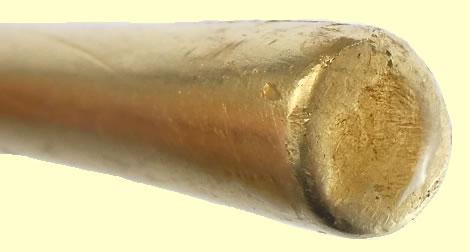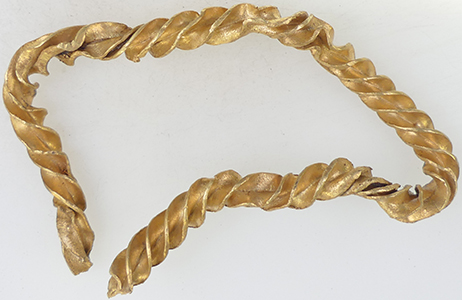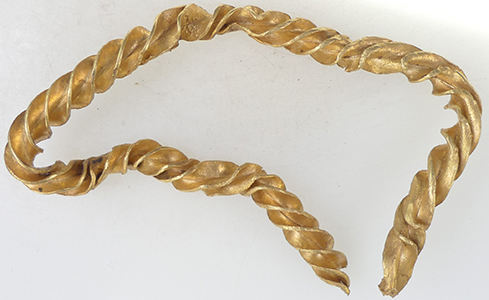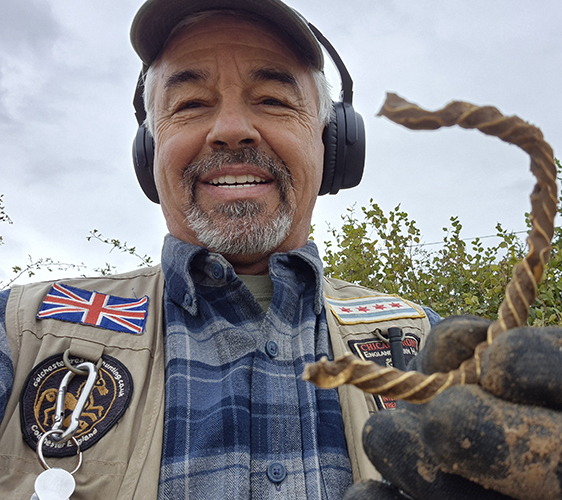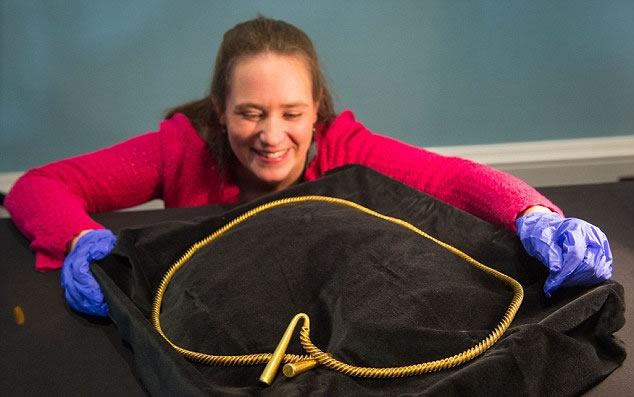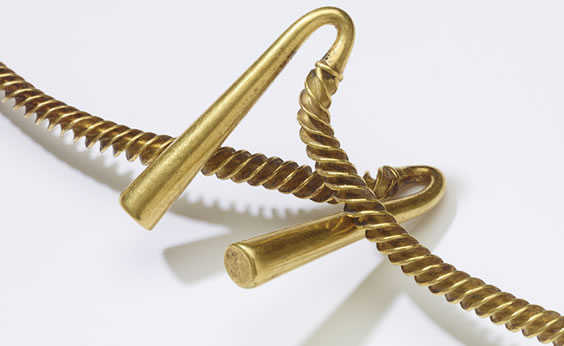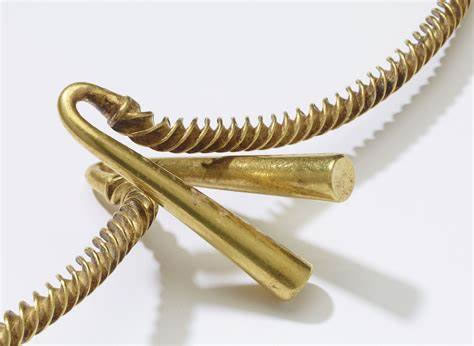

Metal detecting holidays in England with the World's most successful metal detecting club.20 years plus.
Twinned with Midwest Historical Research Society USA.
Gold Torcs
Cal Dave
The Clubs first ever gold torc find - aquired by Colchester museum 1300BC gold Torc - 33.72g
Aussie Brad
2nd - 1300 BC gold Torc - reported as treasure to museum 27.8g, 82.3 mm x 7.7 mm dia
Chicago Ron
Our 3rd 1300 BC gold Torc - reported as treasure to museum 0.7 oz, 20g 100mm x 7.7 mm dia
Great link on Celtic gold torcs with pictures
Cambridgeshire Gold torc
Cambridgeshire Gold torc - clasp shape Found in Cambridgeshire, the torc, dating from 1100 to 1300 BC, is one of the largest and most spectacular to be found, experts said. Torcs were normally worn around the neck as fashionable jewellery in England and Ireland. But this one, weighing 732g, is too large to fit a person's waist. It may have been designed to be worn over thick winter clothing, as a sash, or by a prized animal in the course of a sacrifice.
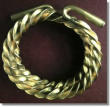 |
|
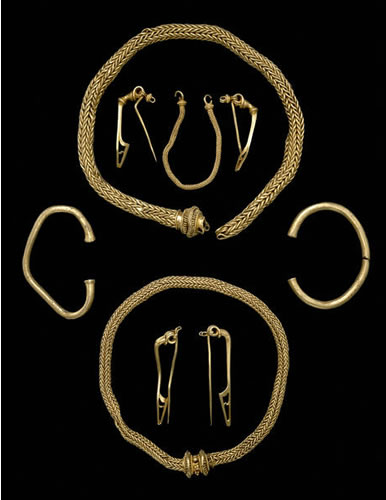 |
|
|
The Winchester Treasure The gold was exceptionally pure, at above 90%. The necklace torcs had clasps of a type unknown to Celtic craftsmen. The decoration of gold globules ('granulation') and gold wire ('filigree') had been fixed with an invisible bond by a technique known as 'diffusion soldering'. And whereas most torcs were rigid, these were thick but flexible chains of interwoven rings. Who made the Winchester torcs? - Torcs were symbols of wealth, power and courage across barbarian Europe. The type and decoration of the objects are certainly Celtic. The brooches are of a 'safety-pin' form commonly found in pairs, because they were used to attach the cloaks worn by Iron Age people. But the techniques of manufacture are Roman. Was the master-craftsman who made them an immigrant in service to a great British lord? Or were the treasures a diplomatic gift, deliberately crafted in Celtic style to appeal to 'barbarian' taste, perhaps even a present from Caesar to a client-king? |
|
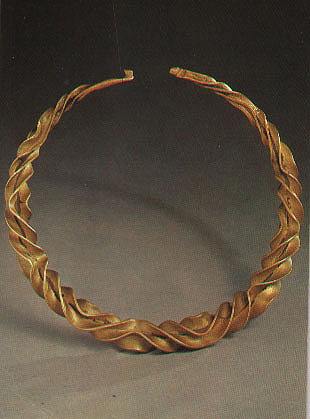 |
|
|
Uddelerveen,
bronze age, bronze torc
|
|
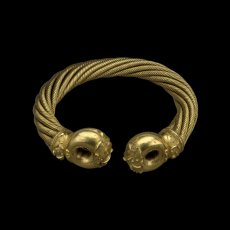 |
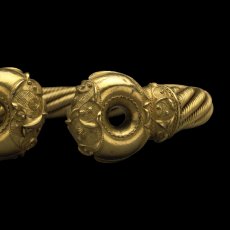 |
|
The
Great Torc from Snettisham
The most famous object from Iron Age Britain This torc was made with great skill and tremendous care in the first half of the first century BC. It is one of the most elaborate golden objects made in the ancient world. Not even Greek, Roman or Chinese gold workers living 2000 years ago made objects of this complexity. The torc is made from just over a kilogram of gold mixed with silver. It is made from sixty-four threads. Each thread was 1.9 mm wide. Eight threads were twisted together at a time to make 8 separate ropes of metal. These were then twisted around each other to make the final torc. The ends of the torc were cast in moulds. The hollow ends were then welded onto the ropes. The torc was found when the field at Ken Hill, Snettisham was ploughed in 1950. Other hoards were found in the same field in 1948 and 1990. The torc was buried tied together with a complete bracelet by another torc. A coin found caught in the ropes of the Great Torc suggests the hoard was buried around 75 BC. Diameter:
20 cm |
|
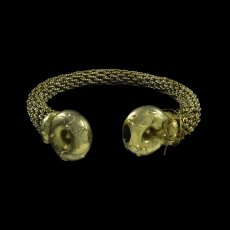 |
 |
|
Silver
torc from the Snettisham hoard L
The torc was made in the same way as many of those made of gold found at Snettisham. Thin threads of silver were twisted together to make ropes, and the hollow terminals (ends) then added. The metal torcs made in this way were heavy and needed a large quantity of valuable metal to make them. Imagine wearing the weight of two bags of sugar around your neck in gold or silver! Diameter:
19.5 cm |
Gold
torc from the Snettisham hoard L
This torc was placed in a small hole in the ground with 20 other torcs. First 10 gold torcs, including this one, and two silver torcs were placed in the ground along with two bronze bracelets. Then soil was thrown in the hole before another 7 torcs were carefully placed on top. Five of these torcs were made of silver and two from bronze. Did each torc belong to a different person? Did the older or the more important people wear gold rather than silver or bronze torcs? We will never be able to answer these questions with any certainty. Diameter:
21 cm |
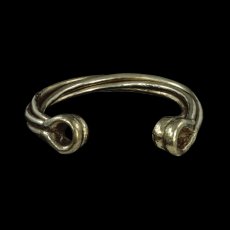 |
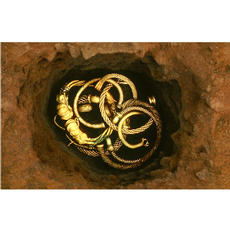 |
| Electrum
torc from Snettisham (Hoard G)
This torc is part of hoard G found at Snettisham, which was buried in a small pit cut into the rock. It contained 3 torcs made of electrum (a naturally occurring alloy of gold and silver), 7 silver torcs and 10 bronze torcs. Different
types of torcs were made and worn by the people who buried the treasure
at Snettisham. Many, though not all, were made from twisted ropes of
metal. This massive torc is a more simple type of the twisted rope torcs.
It is made from four different bars of electrum, which have been slightly
twisted around each other. The ends of the bars were then bent around
each other to make the loop shaped terminals |
Iron
Age, around 75 BC From Ken Hill, Snettisham, Norfolk, England These are the crown jewels of Norfolk of over 2000 years ago. They are gold and silver torcs that were worn around the neck to display the wearer's importance. Torcs were first found at Snettisham in 1948 and 1950, and experts thought no more were buried there. Then in 1990, metal detectorist Charles Hodder found 9 kilograms of gold and silver fragments and ingots at the site. He reported his finds and helped archaeologists excavate the field. They unearthed seventy-five complete torcs, carefully buried in small pits. But there are stories that another hoard was found at Snettisham. Known as 'the Bowl hoard', it is thought to consist of a silver bowl containing large numbers of Iron Age coins. It was illegally removed from the site and allegedly smuggled out of Britain and sold. Little more is known - a vital piece of our history has probably been lost forever. |
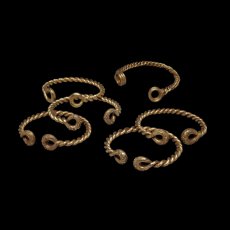 |
 |
|
Gold
torcs from the Ipswich Hoard
Five of these gold torcs were found during construction work near Ipswich in 1968. The sixth was found nearby about a year later. They are one of two of the most famous collections of Iron Age gold torcs in The British Museum. The other, much larger, was found at Snettisham in Norfolk. Torcs are ornaments worn around the neck. A person would have had to have had a neck smaller than 18.7 cm in circumference to wear these examples. Scientific analysis by the Department of Scientific Research at The British Museum shows that the torcs are made from an alloy (mixture) of 90% gold and 10% silver. This is an important discovery as it helps archaeologists to estimate more accurately when they were made. Gold objects made from between 150 and 75 BC have a high percentage of gold. Gold objects made after 75 BC have more and more silver mixed with the metal. The scientific results suggest this set of torcs were made around 75 BC. But highly valuable objects like these might have been worn for many years before they were buried. Each torc was made by twisting two rods of gold around each other. The ends, the 'terminals', were each cast on to the twisted rods using the lost wax technique. Each terminal is hollow, the La Tène-style decoration cut into the clay mould so that it stands up from the surface of the ends, which were then polished. Each terminal, of all the torcs, has a slightly different pattern from its pair. Diameter: 18.7 cm |
|
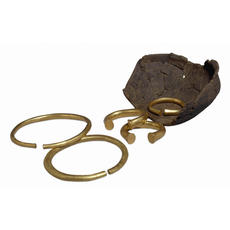 |
|
|
The
Milton Keynes hoard
The hoard comprises two gold torcs, three bracelets and a tiny fragment of bronze rod or wire found within an undecorated pottery bowl. It was found by two metal-detectorists, whose diligence in reporting the find to local archaeologists ensured that the information on the context of the find is very good. As a result we have the first certain association between a gold hoard and pottery for the British Middle to Late Bronze Age (about 1500-800 BC). Bronze Age gold metalwork is usually found in isolation, but the associated pottery vessel helps confirm, and may eventually refine, the dating of this hoard. The find provides an invaluable link between gold types and the broader social and economic picture for Bronze Age Britain. Weighing in at over two kilos, this is one of the biggest concentrations of Bronze Age gold known from Britain and seems to flaunt wealth. The two torcs are penannular (open) neck-rings of elliptical cross-section. One torc is decorated with incised lines, except for a plain strip along the rear face, and with more complex groove decoration near the terminals. The other is only decorated near the terminals, with a band of close-set grooves. Two of the bracelets are very chunky 'C'-shaped rings of elliptical cross-section. The third has an octagonal cross-section. Diameter:
14.59 cm (larger torc: external) |
|
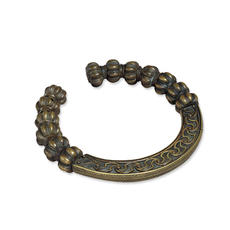 |
|
|
Brass
torc
The torc was made sometime between AD 50 and 200 and was found inside a bronze bowl buried in a bag. At this time, the Romans had conquered southern Britain and at different times occupied southern Scotland. These types of torcs have been found only in northern England and Scotland. This shows that they are a type of very distinctive costume, only used in this part of Roman and Free Britain. Diameter: 16 cm (internal; max.) |
|






